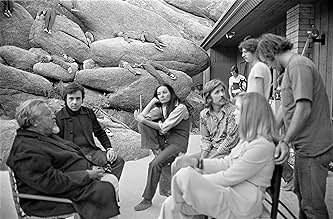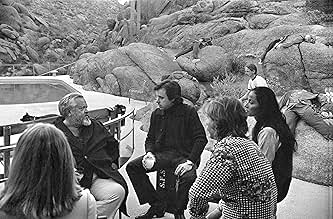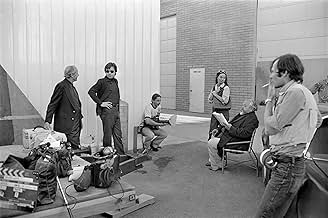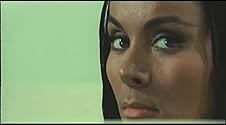At a media-swamped party to celebrate his 70th birthday and screen his avant-garde film-in-progress, a legendary but jaded Hollywood director is faced both with voracious fans and unsettling... Read allAt a media-swamped party to celebrate his 70th birthday and screen his avant-garde film-in-progress, a legendary but jaded Hollywood director is faced both with voracious fans and unsettling questions about what became of his lead actor.At a media-swamped party to celebrate his 70th birthday and screen his avant-garde film-in-progress, a legendary but jaded Hollywood director is faced both with voracious fans and unsettling questions about what became of his lead actor.
- Awards
- 9 wins & 8 nominations total
- John Dale
- (as Bob Random)
- Director
- Writers
- All cast & crew
- Production, box office & more at IMDbPro
Featured reviews
Orson Welles' final film is chaotic and unwieldy, but also very haunting and melancholy. The soundtrack is amazing. There is frankly a sliver of a plot. An aging director attempts to make a comeback as Hollywood has drifted away from his era as he throws a big birthday party in which journalists, critics, admirers and some industry professionals join to celebrate. It soon becomes apparent that reporters are there to ascertain information about more than his work. His new film that is in the works is shown. We get to see an unfinished film within a film that is titled "The Other Side of the Wind", one that is sexually explicit.
The late John Huston portrays Jake Hannaford, the director whose approach to filmmaking has earned him a great following and his relationships with the actors he works with makes him a lightning rod of controversy. Huston's sepulchral voice and domineering presence make him flawless in the role as Hannaford. Peter Bogdanovich is well utilized as a younger, successful director whom Hannaford has taken under his wing but whom now Hannaford consults on how to better reach audiences of the new era.
This film is not flawless. The experience of seeing this at long last outweighs its drawbacks. There are some parts of this film that drag a bit. But there are also many, many scenes that are just astounding and I'm so happy they were finally brought to the big screen. Although this film is inconsistent in its narrative thrust, it returns very quickly to its busy, slightly manic state. I don't know if Welles deliberately left this unfinished. What I can say is that the editing is superb and provides us with a film that is a lasting testament to Welles and his legacy as a filmmaker. Highly recommended.
In comparison to Fellinis movie, 'The Other Side of the Wind' is equally carnvalesque, more deconstructivist - individual roles seem to disolve or fade into each other in the more - more prone to abandon narrative structure, less cheerful, but ultimately more bitter. Whereas Fellini -- through Mastroianni -- seems to comment his own shortfalls as an artist and his faustian, sexual desire with a mischievous, but upbeat wink in the end, the narrator's final epigramm as well as the title of Welles' last movie seems to suggest a more macbethian philosophy: it was all a story full of sound and fury, signifying nothing, and the acclaimed director is nothing but the other side of the wind, blowing in a conversation.
Best known for his all-time classics CITIZEN KANE (1941) and TOUCH OF EVIL (1958), Welles left mountains of copious production notes, and almost 100 hours of footage in multiple formats, and in both color and black and white stock, on this project that, even today, might best be described as experimental. Over the past 30 years there have been numerous attempts to raise the money required to finish the film, but all fell short until this one spearheaded by Peter Bogdanovich and Beatrice Welles (Orson's daughter).
In what we can only interpret as semi-autobiographical, what we see on screen is the making of a documentary on a legendary director's comeback film (his poke at artsy filmmakers). Clips of the unfinished film are shown throughout, while an industry party plays out, and numerous documentary filmmakers capture the scene from various angles with their always-present cameras. Got that? Don't worry, it takes at least a few minutes as a viewer to get the rhythm and layers of what's unfolding before our eyes.
John Huston (himself an industry legend with 2 Oscars and 15 nominations) plays director Jake Hannaford, who is walking the fine line between Hollywood power and has-been. It's his 70th birthday party, and Hannaford is compared to Hemingway (a description that better fit Huston than Welles), silently endures insinuations of his closeted homosexuality, desperately seeks funding to finish his film, and skulks around his own party winding through the hangers-on and those waiting for the final curtain.
Hannaford's artsy film within a film, at least the clips we see, feature an inordinate amount of nudity from the leading lady (played by Welles 4th wife and the film's co-writer Oja Kodar), and some ultra-coolness from the lead actor John Dale (played by Robert Random). Part of Hannaford's desperation (both professional and persona) stems from a James Dean-type Dale walking off the set mid-picture.
Guests at the party include Peter Bogdanovich as director Brooks Otterlake, a young director once mentored by Hannaford. It's an example of the student becoming the teacher. Susan Strasberg (daughter of famed acting coach Lee Strasberg) plays film critic Juliet Riche, a thinly-veiled portrait of Welles nemesis Pauline Kael. Other familiar faces in the cast include: Lilli Palmer, Mercedes McCambridge (Oscar winner), Edmond O'Brien (Oscar winner), Cameron Mitchell, Paul Stewart (from CITIZEN KANE), Tonio Selwart, Geoffrey Land, Norman Foster, Dennis Hopper (2 Oscar noms), Claude Chabrol, Stafford Repp (Sgt O'Hara from "Batman" series), plus Cameron Crowe (Oscar winner), William Katt, Frank Marshall (5 Oscar noms), Rich Little, Leslie Moonves (recently fired in disgrace CBS President), and Paul Mazursky (5 Oscar noms). It's fascinating to see so many we recognize from more than 40 years ago. Of course, it's Huston, with his face that's made for black and white film, who is the dominating figure (his scenes were filmed prior to his work on CHINATOWN).
It's easily viewed as a satire on the film industry, and it's quite a fun, messy-by-design, now retro look at a fragile industry - and the even more fragile people who make movies. Welles' love/hate relationship with the industry takes on an art form. He shows what's good and what's deplorable. Is it an experimental movie commenting on the post-studio world of independent filmmaking, or is it an iconic filmmaker, glory days behind him, in the midst of self-reflection. Perhaps it's both. In addition to Welles' early editing efforts, Oscar winning editor Bob Murawski (THE HURT LOCKER) was brought in to finish up what can now be described as a master class in film editing. It's a wild ride for us film nerds. Are you ready to join us?
Were you compelled by the character study of Citizen Kane? Were you thrilled by Touch of Evil? Then get ready for something unlike any of those or unlike anything. This is the mockumentary before Reiner or Guest, the improvisational dramedy before Apatow.
The entire point of this movie is that there's no point to this movie. Here is Orson Welles's most talked about movie about talking about a movie. His film about a film within a film. Orson Welles deliberately subverts Orson Welles to make an art film contained within an art film making fun of art films. John Huston plays John Huston playing Orson Welles as Orson Welles. Peter Bogdanovich plays himself as his own ripoff. There's a party celebrating a celebrated filmmaker making a film making fun of filmmakers. Nothing happens. So much happens. We learn everything about a legendary director about whom we learn nothing.
This film is a glimpse into the psyche of a filmmaker who wants to make films but has no idea how to keep making films. He wants to be commercially successful without compromising his integrity. He wants to make personal films for an impersonal audience. He wants to make something sexy despite being prudish. This movie isn't really for anyone; this movie is really for everyone.
It wasn't until the end of his life that Orson Welles realized the most important story he needed to tell was his own. It's a story whose only concern is that it was told, whether or not you like it. So watch it. Or don't. This movie doesn't care either way.
And if this review left you feeling confused, then I gave you an accurate impression of the film.
Did you know
- TriviaThe movie was filmed between 1970 and 1976, with editing continuing into the 1980s. When he died in October 1985, Welles left behind nearly 100 hours of footage and a work print consisting of assemblies and a few edited scenes.
- GoofsIn one confrontational scene, Brooks Otterlake, who Gregory Sierra's character, Jack Simon, refers to as, "Kid", is simultaneously Peter Bogdanovich and Rich Little. This is small overlap is because Rich Little was originally cast as the black turtleneck wearing, voice imitating director, Brooks Otterlake. However Bogdanovich replaced him, and Little's part was reduced to that of a Party Guest.
- Quotes
[last lines]
Jake Hannaford: Who knows, maybe you can stare too hard at something, huh? Drain out the virtue, suck out the living juice. You shoot the great places and the pretty people... All those girls and boys. Shoot 'em dead.
- Crazy creditsAfter the end credits, Hannaford's voice is heard saying "Cut"
- ConnectionsFeatured in AFI Life Achievement Award: A Tribute to Orson Welles (1975)
- SoundtracksLes Délinquants
Written and performed by Michel Legrand
Published by WB Music Corp. o/b/o Productions,
Michel Legrand + Editions Royalty
Courtesy of Decca Records France
Under license from Universal Music Enterprises
- How long is The Other Side of the Wind?Powered by Alexa
Details
- Release date
- Countries of origin
- Official site
- Languages
- Also known as
- The Other Side of the Wind
- Filming locations
- Production companies
- See more company credits at IMDbPro
- Runtime
- 2h 2m(122 min)
- Color
- Sound mix

























